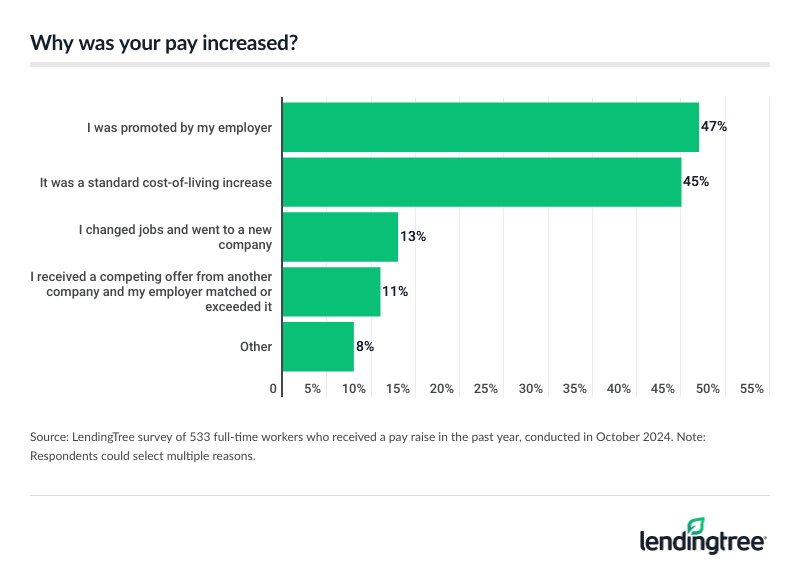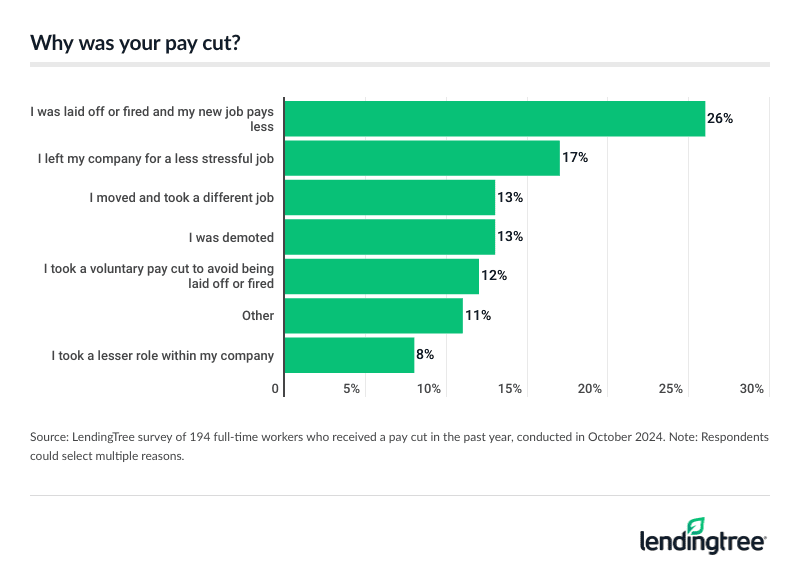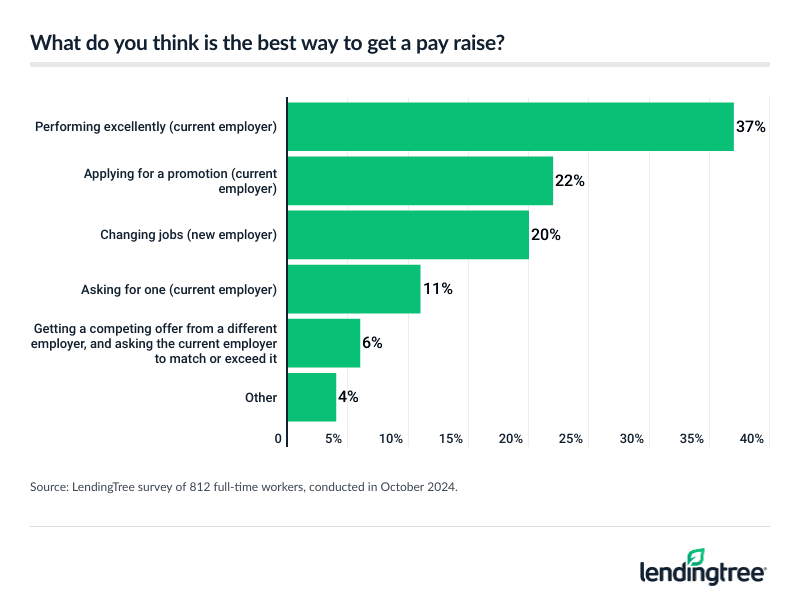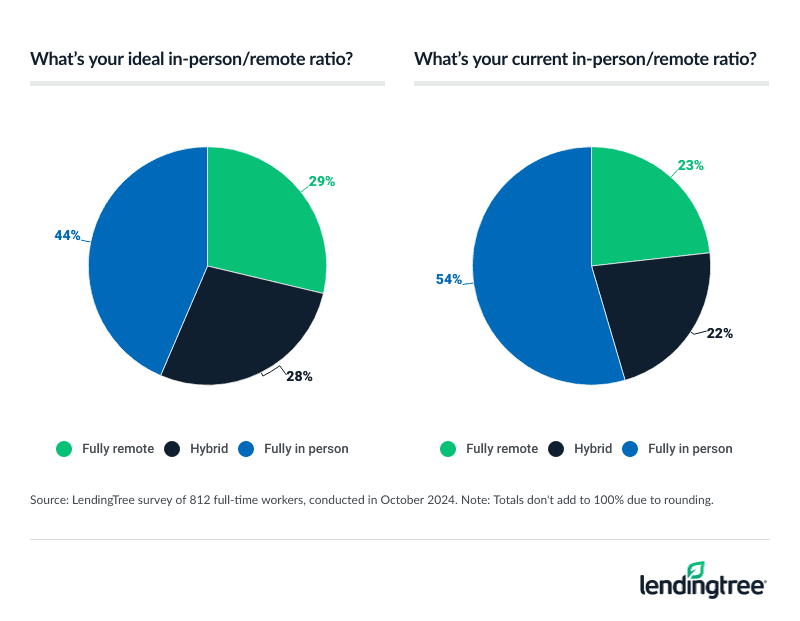82% of Full-Time Workers Who Asked for Pay Raise Got One
Asking for a raise might be the single most nerve-wracking conversation you can have in the workplace. Well, other than politely requesting your co-worker stop microwaving fish in the breakroom.
But those sweaty palms could pay off. More than three-quarters of the full-time workers we surveyed who asked for a raise told us they received one this past year. Not everyone was so lucky, though. Here’s what we found.
Key findings
- Ask and you shall receive (most of the time). 82% of full-time workers who asked for a pay raise in the past year received one in that period — while 66% of full-time workers got one, regardless of whether they asked. Among full-time workers who received a pay increase, 51% say it was less than $5,000, while 24% got $5,000 to $9,999.
- Conversely, just about a quarter of full-time workers had a pay cut this past year. Of the 24% of workers who saw a dip in their base salary, 26% say they were laid off or fired and took a lower-paying job, while 12% say the pay cut was voluntary to avoid a layoff or firing. Another 17% in this group took less money for a less-stressful job elsewhere. While 34% of this group saw their pay decrease by less than $5,000, 19% experienced a pay cut of $20,000 or more.
- Nearly two-thirds of full-time workers are optimistic about their future. 65% expect their pay to increase in the next year. When asked what they think is the best way to receive a raise, 37% said excellent performance, 22% said a promotion and 20% said a new employer.
- Americans are willing to go into an office, but some require extra incentive. Among those not in an office every day, 57% are open to a fully in-person role — but only with a pay raise. Most of this group would be willing to transition to fully in person with a raise of less than $10,000, though 10% would want $20,000 or more.
82% of full-time workers who asked for a raise got one
Americans were more likely than not to get a pay raise this past year: 66% of full-time workers we surveyed received a pay bump, whether they asked for one or not. But raises were more common among workers who asked. Of workers who asked for a raise, a whopping 82% received one.
However, not all raises are created equal. About half (51%) of the raises were less than $5,000.
Workers don’t always have to switch jobs to get a bump in pay
If you want to make more money, you must job hop — it’s a refrain heard time and time again. Our survey shows that might not be the case. Just 13% of full-time workers who got a pay raise did so by moving to a new company.
Rather, it seems like current employers are focusing on retaining the talent they have. Nearly half (47%) of workers who got a raise received it because they were promoted internally. Another 45% who received a raise say they were granted a standard cost-of-living increase. And 11% say they got a raise after receiving a competing offer from another company, and their employer matched or exceeded it.

Men are more likely to ask for a raise than women, but Gen Zers are the most likely of all
A LendingTree survey conducted earlier this year found that women feel more financial strain than men. Unfortunately, that makes sense. Based on the most recent Pew Research Center data, women earn 82% of what men do, on average.
According to our new survey, women are also less likely to ask for a raise. Only 35% of women asked for a pay increase, versus 49% of men. Women and men were a little more even when it came to receiving raises, at 63% and 67%, respectively.
But regardless of gender, Gen Zers (ages 18 to 27) are the most likely to advocate for themselves — 50% asked for a raise in the past year. Millennials (ages 28 to 43) are close behind, at 49%. Being bold during paycheck negotiations isn’t the only thing these generations have in common — 55% of Gen Zers and millennials also have a side hustle.
24% of full-time workers took a pay cut in 2024, mostly due to layoffs or firings
Not everyone was fortunate enough to get a bump in their checks. Almost a quarter of our survey respondents who work full time (24%) got a pay cut in the past year. A little over a quarter (26%) of pay cuts were due to layoffs or firings. A small group of workers (12%) took matters into their own hands by taking a voluntary pay cut to avoid being laid off or fired.

For some, a pay cut is worth it for less stress
A not-insignificant percentage of respondents prioritized their mental health over their wallet. Of workers who received a pay cut, 17% say they took a cut for a less stressful job, and 8% took a lesser role within their company.
It’s essential to put your health first, but money is a huge source of stress when you can’t afford your bills. Here’s what Schulz says to those considering a pay cut (or facing a layoff):
“It can be really tough. Patience can be key because it can take a long time to find that next role, especially if you’re a high-salary employee. One of the best things you can do is to have enough savings built up to take some of the pressure off you to find a job immediately. That can certainly be easier said than done, but the effort can be worth it. If you can muster up six months of expenses in your emergency fund, that can allow you to be a little more selective when it comes to which jobs you seek.”
65% of full-time workers expect to get a raise in the next year, and many think the path to higher pay is through excellent performance
The future is bright for the majority of our survey respondents — 65% of full-time workers think they’ll get a raise in the next year. Not everyone is as hopeful, though. Almost a third expect their pay will stay the same, and 5% think they’ll take a pay cut.
How workers predict they’ll get a raise could be a signal that the era of quiet quitting is over. In fact, 37% of workers say the best way to get a raise is by performing excellently for their current employer. Another 22% feel that applying for an internal promotion is the best way to get a boost.
And although our survey shows that most workers got a raise when they asked for one, only 11% think this is the most effective strategy for a pay bump.

The Great Reshuffle may be coming to a close
Around this time last year, a LendingTree survey found that 57% of workers were considering looking for a new job. Today, 88% of the full-time workers we surveyed are satisfied with their current roles. Not only that, but just 20% think the best way to get a raise is by switching employers.
That’s not to say that everyone is happy where they’re at.
Almost a quarter of full-time workers have changed employers in the last year. Gen Zers were the biggest group to jump ship, at 33%. Similarly, 30% of those earning $100,000 or more also switched jobs this year. A few other cohorts —millennials, men and parents of young kids — weren’t far behind, at 28% each.
57% of remote workers would need a raise to RTO
The push for return to office (RTO) is a contentious one, and 57% of the remote and hybrid workers we surveyed say they would only go back to the office five days a week if they got a raise. Still, the majority of them would only require a modest bump in pay.
- Less than $5,000: 20%
- $5,000 to $9,999: 36%
- $10,000 to $14,999: 19%
- $15,000 to $19,999: 16%
- $20,000 or more: 10%
That said, only 7% of workers who aren’t fully in office would quit their job if they were required to go back to the office (whether their employer offered a raise or not).
Whether in an office or at home, most are happy where they’re at
Are people stuck in a cubicle when they’d rather be home with their dog? Our survey says no, not really. To start, know that most of the workers we surveyed (54%) work fully in person, 22% are hybrid and 23% are fully remote.
As a whole, 44% of full-time workers prefer the full in-office experience. The preferences for hybrid and remote are nearly identical, at 28% and 29%.

Breaking this data down even further, we found that most are happy with their current work arrangements:
- Of those who work fully in an office, 77% prefer it that way. 10% of that group wishes they worked fully remote.
- Of those who work hybrid, 81% prefer it that way. 16% of that group wishes they worked fully remote.
- Of those who work fully remote, 83% prefer it that way. 6% of that group wishes they worked fully in person.
Maybe this is a sign that bosses are more willing to let their employees work where they feel most comfortable. That, or workers may prioritize working for a company that aligns with their preferences.
Tips from an expert: Effectively asking for a raise
You probably won’t get a raise by simply demanding one — there’s an art to the ask. Be prepared to state your case, and come with data to back it up. Here’s what Schulz — author of “Ask Questions, Save Money, Make More: How to Take Control of Your Financial Life” — recommends:
- Know that timing matters. “If you tell your boss at 5 p.m. on Friday that you want to talk compensation, you’re probably not going to get anywhere. Also, if you know that your company has a policy of only doing promotions and raises at certain times of the year, pushing too hard outside of those windows can be counterproductive.”
- Know your worth. “There’s never been more information out there about salaries and benefits, and people have never been more open to sharing their experiences with others. It’s even becoming less taboo to share your own salary. That makes it easier than ever to have a real, meaningful read on how much someone in your position should be making and where you currently stand in relation to others like yourself. Once you know those things, it’s far easier to stand up and ask confidently for a raise.”
- Track your accomplishments frequently. “We’re all busy, but taking the time once a week or a couple times a month to write down your accomplishments can make a big difference when asking for a raise in the future. If you don’t make those notes, it can be easy to forget what we’ve done over time. When that happens, you may undersell how much of an impact you’ve had.”
Methodology
LendingTree commissioned QuestionPro to conduct an online survey of 2,049 U.S. consumers ages 18 to 78 from Oct. 1 to 3, 2024. The survey was administered using a nonprobability-based sample, and quotas were used to ensure the sample base represented the overall population. Researchers reviewed all responses for quality control.
We defined generations as the following ages in 2024:
- Generation Z: 18 to 27
- Millennial: 28 to 43
- Generation X: 44 to 59
- Baby boomer: 60 to 78
